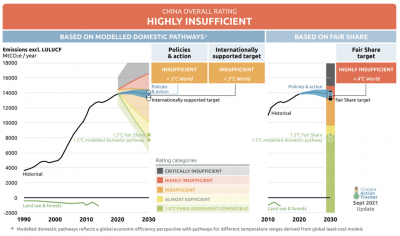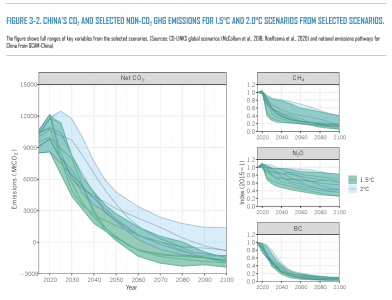Is China Doing Enough on Climate Change? COP26 Version
Chinese leaders have an opportunity to increase ambition and clarify the country’s climate plans
As COP26 kicks off in Glasgow, Scotland this week, the world is confronted with a basic reality. Current national climate pledges fall well-short of the Paris Agreement goal to keep global average temperature increase this century well below 2°C and to pursue efforts to limit temperature increase to 1.5°C above pre-industrial levels. The UN’s 2021 Emissions Gap Report finds that under current pledges temperatures will still rise by 2.7°C by the end of the century. To hit the 1.5°C goal, the world must reduce annual emissions by nearly half within the next eight years. To put this in perspective, the 28 GT of CO2 equivalent needed above current pledges is only slightly less than the total emissions of the G20 in 2019.
Let that sink in for a moment.
Is it Enough?
Given the woeful global shortfall in ambition, let’s turn to the question of whether China is doing enough. As a reminder, China has made five key climate announcements since late 2020.
- In September 2020, Xi Jinping announced goals to peak emissions before 2030 and to achieve carbon neutrality before 2060. In December 2020, he added further detail on commitments for 2030 (carbon intensity, non-fossil energy share, forest stock, and wind and solar installed capacity).
- In March 2021, China published its 14th Five Year Plan (2021-25) with interim targets for energy and carbon intensity and non-fossil energy share.
- At the April 2021 Leaders Climate Summit, Xi Jinping mentioned China’s intention to “strictly control coal-fired power generation projects, and strictly limit the increase in coal consumption over the 14th Five-Year Plan period [2021-25] and phase it down in the 15th Five-Year Plan period [2026-30].”
- In September 2021, Xi Jinping announced that China “will not build new coal-fired power projects abroad.”
- In the run up to COP26, China released two high-level documents – a working guidance document on the carbon peaking and neutrality goals, and an action plan for the 2030 peaking goal. These are the first part of what China is calling its “1+N” program on climate change. At COP26, China submitted a long-term development strategy, pursuant to Article 4(19) of the Paris Agreement.
Much of the media coverage on China and COP26 has focused on the prospects for US-China cooperation given rising geopolitical tensions, Xi Jinping’s absence from the Glasgow meeting, and whether China is going to play an important role in ratcheting up ambition at COP26.
As an initial matter, we see no signs of a Paris Agreement redux on US-China cooperation. But it’s not over until it’s over. One can hope. Furthermore, Xi Jinping’s absence resulted in an unusually low profile for China on Day 1 of COP26. Whereas the heads of the world’s leading emitters gave in-person statements streamed online, Xi Jinping only submitted a brief written statement that offered no new information about China’s intentions. I doubt if this signals any wavering of Chinese national policy commitment to climate change, but it does seem like a missed opportunity. This COP26 is the critical first ratchet under the Paris Agreement and the world is hungry for ambitious commitments from all the countries, but especially from the leading emitters like China. China’s relatively low-key participation in COP26 so far is disappointing as we know that China could shake the world if it pushes its climate commitments further.
Most importantly, though, on the question of whether China is currently doing enough, the short answer is “no.” But China has been getting closer to having an adequate program and it now sits at the helm of a massive carbon regulatory system, more than 15 years in the making, that offers the foundations for reforms consistent with a 1.5°C goal.
A few studies help us to understand the dynamics here.
China Climate Tracker (CAT) rates China’s climate pledges as “highly insufficient.” By comparison, the US and EU are rated as “insufficient;” India and Australia “highly insufficient;” Russia “critically insufficient.”
CAT says that China’s current pledges are “compatible with warming levels of between 3 °C and 4 °C by the end of the century, if all countries followed this ambition.” Furthermore:
To… become compatible with 2 °C (“almost sufficient”), China would need to peak emissions as early as possible and decrease coal and other fossil fuel consumption at a much faster rate than currently planned – and set clear phase-out timelines.

Other analysts agree that China’s climate program could be compatible with a 1.5°C target, but that it would require essentially immediate peaking and much faster coal and other fossil fuel phase-out timelines. Keep in mind that China’s current goal is to peak “before 2030” and to phase down coal in the 2026-2030 15th Five Year Plan period.
According to a 2020 Energy Foundation report,
Earlier peaking and faster long-term reductions will help to limit China’s cumulative CO2 emissions. Indeed, both global and national studies consistently call for China’s emissions to peak almost immediately to limit temperature change to 1.5°C. Scenarios that limit warming to 2°C may peak toward 2030.

Another study by Duan, et al. says that China’s 2060 carbon neutrality pledge is “largely consistent” with the 1.5°C goal. This would require China’s fossil fuel consumption to be “dramatically reduced” and for coal demand to fall to near zero by 2050. The modelled 1.5°C scenarios in the study all “include rapid CO2 reductions over the next 5-10 years whereas China has only pledged to peak its emissions before 2030.”
I hope that Chinese representatives will take the opportunity at COP26 in Glasgow to help the world understand how the country intends to shift more fully towards a 1.5°C compatible emissions trajectory. Much more needs to be done, but China is also doing much more on climate change than many realize.
Reader Comments
4 Replies to “Is China Doing Enough on Climate Change? COP26 Version”
Comments are closed.







There is some reporting that China was irritated by the ramping up of target ambitions from +2C to +1.5C when it had agreed to +2C. While I understand that progress on climate is a developing thing and, given its importance, countries of the world do not fund climate science, oceanography, and geophysics enough, still, as a matter of fact, this was “moving the goalposts.” It’s also possible that the IPCC process, hobbled by countries like Saudi Arabia (e.g., consensus vs majority or 2/3 votes), soft-peddled the risks at the time of the +2C, when +1.5C may have been more appropriate in the first place.
Thanks for your comment. I don’t hear Chinese researchers or regulators complaining about that target in the work we do. China agreed to the aspirational 1.5C goal and Chinese actors I am sure understand it as a reflection of evolving scientific understanding. Perhaps there are some conspiracy theorists who think it reflects some developed world effort to keep China down unfairly, but I don’t hear that viewpoint in my encounters.
Thank you for a thoughtful, nuanced article. The emphasis on earlier peaking seems of particular importance; what countries do the next five years is far more important to us all than what they pledge to do decades hence, and, indeed, what they do this decade will facilitate earlier achievement of those 2050 and 2060 goals so many key countries are setting.
Thanks for the comment, Alex. Agreed.